Analysis of Microeconomic Theories in Small Business Operations
VerifiedAdded on 2022/08/25
|9
|1573
|21
Report
AI Summary
This report delves into the crucial role of microeconomic theories in business operations, particularly for small businesses. It examines key concepts such as the theory of production and cost, emphasizing the importance of efficient resource utilization and understanding various cost structures (marginal, average, variable, and fixed). The report then explores the theory of demand and supply, highlighting their fundamental impact on business decisions, including pricing and production levels. Furthermore, it analyzes different market structures (monopoly, oligopoly, monopolistic competition, and perfect competition) and their implications for business strategies. The production possibility theory is also discussed, illustrating how it helps determine optimal production levels. The report concludes by emphasizing the practical application of these microeconomic theories in small business contexts, providing valuable insights for entrepreneurs in making informed decisions about their ventures.
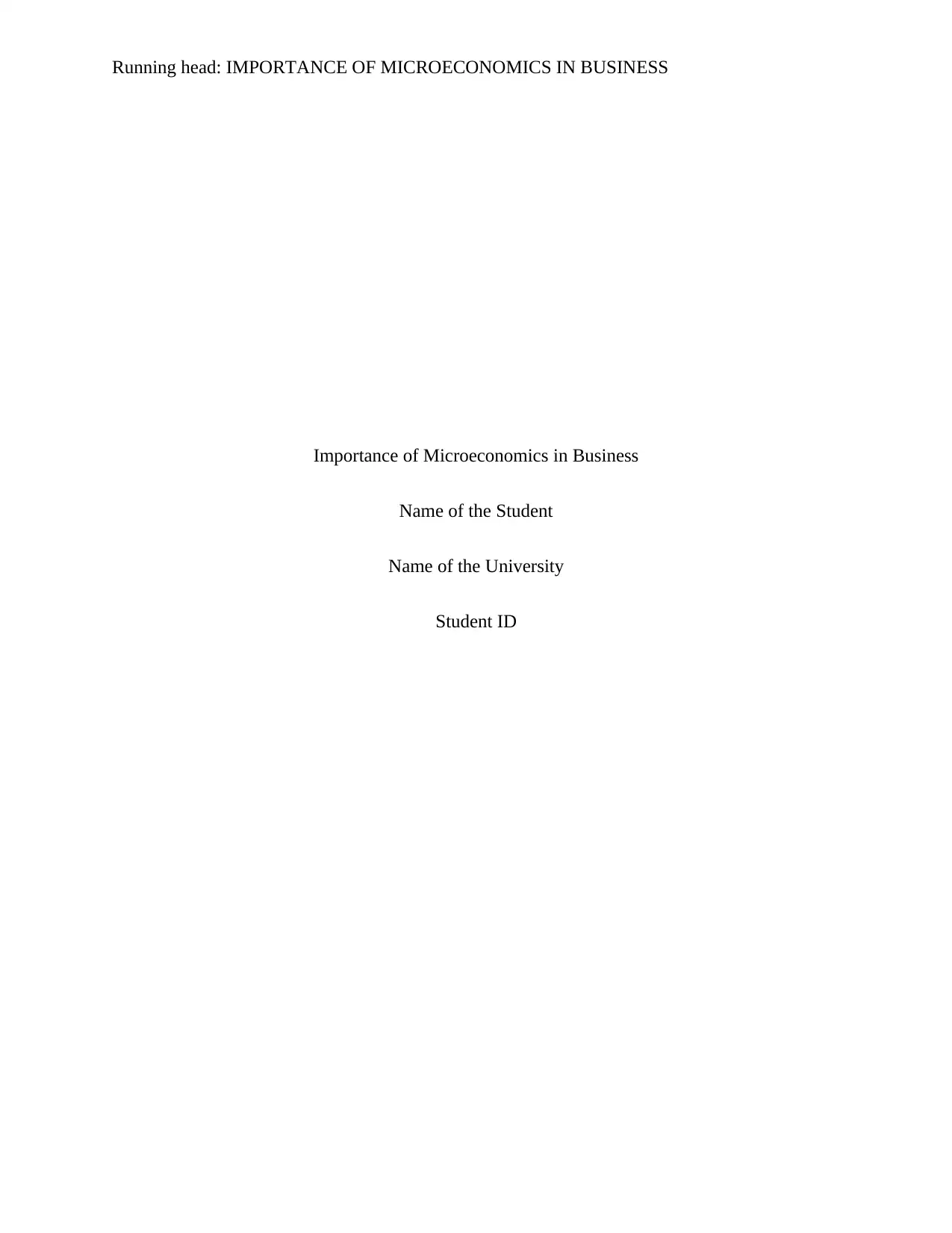
Running head: IMPORTANCE OF MICROECONOMICS IN BUSINESS
Importance of Microeconomics in Business
Name of the Student
Name of the University
Student ID
Importance of Microeconomics in Business
Name of the Student
Name of the University
Student ID
Paraphrase This Document
Need a fresh take? Get an instant paraphrase of this document with our AI Paraphraser
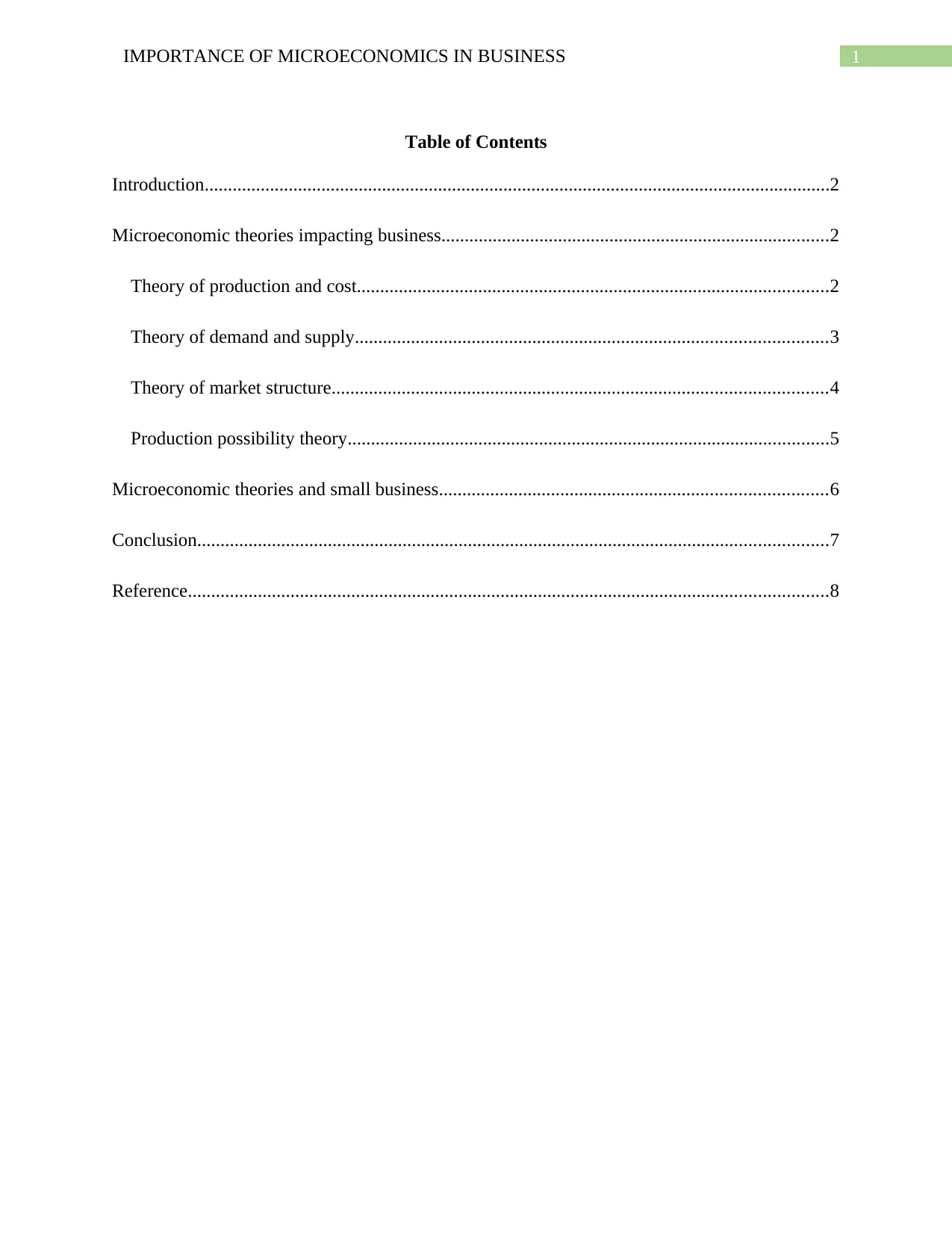
1IMPORTANCE OF MICROECONOMICS IN BUSINESS
Table of Contents
Introduction......................................................................................................................................2
Microeconomic theories impacting business...................................................................................2
Theory of production and cost.....................................................................................................2
Theory of demand and supply.....................................................................................................3
Theory of market structure..........................................................................................................4
Production possibility theory.......................................................................................................5
Microeconomic theories and small business...................................................................................6
Conclusion.......................................................................................................................................7
Reference.........................................................................................................................................8
Table of Contents
Introduction......................................................................................................................................2
Microeconomic theories impacting business...................................................................................2
Theory of production and cost.....................................................................................................2
Theory of demand and supply.....................................................................................................3
Theory of market structure..........................................................................................................4
Production possibility theory.......................................................................................................5
Microeconomic theories and small business...................................................................................6
Conclusion.......................................................................................................................................7
Reference.........................................................................................................................................8
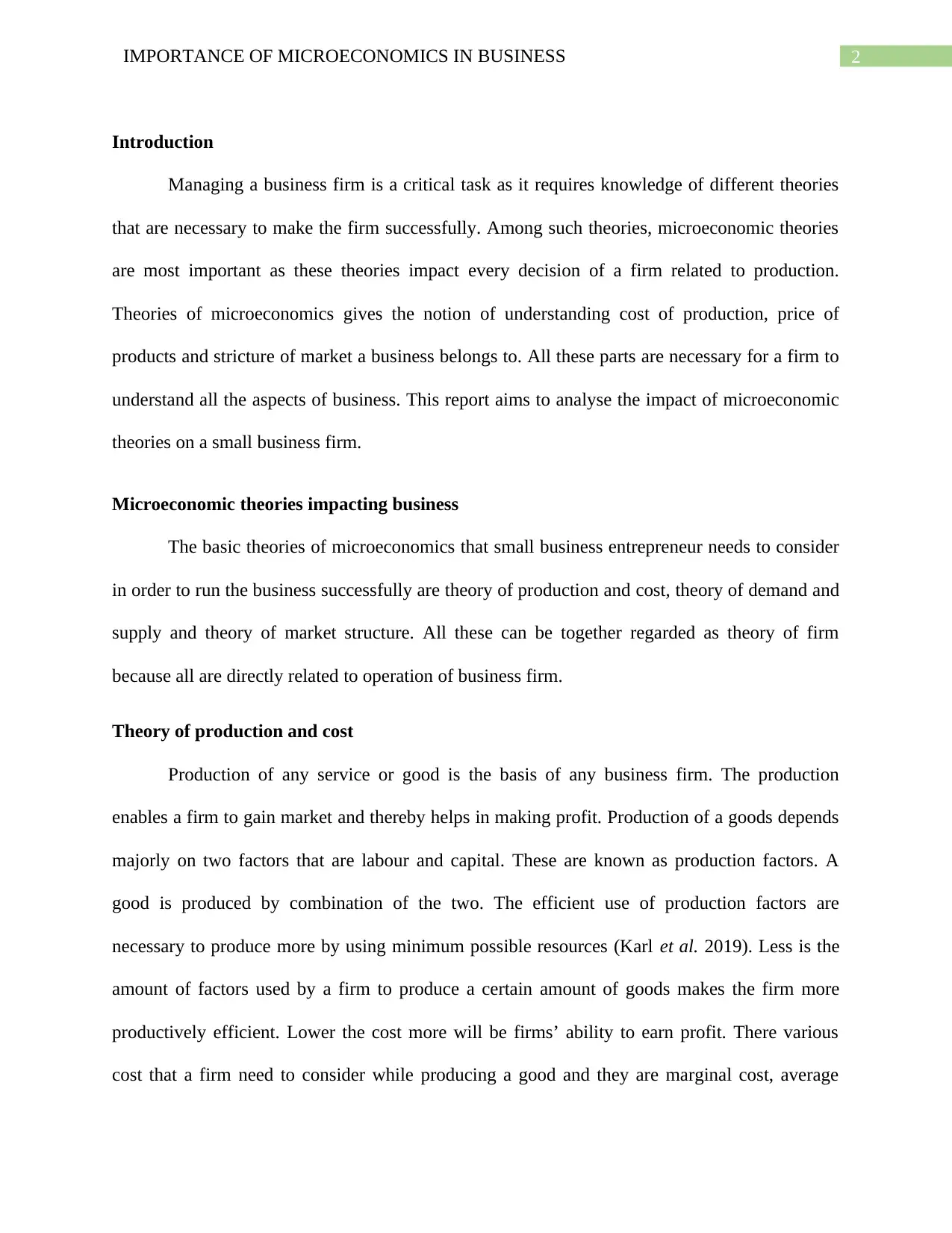
2IMPORTANCE OF MICROECONOMICS IN BUSINESS
Introduction
Managing a business firm is a critical task as it requires knowledge of different theories
that are necessary to make the firm successfully. Among such theories, microeconomic theories
are most important as these theories impact every decision of a firm related to production.
Theories of microeconomics gives the notion of understanding cost of production, price of
products and stricture of market a business belongs to. All these parts are necessary for a firm to
understand all the aspects of business. This report aims to analyse the impact of microeconomic
theories on a small business firm.
Microeconomic theories impacting business
The basic theories of microeconomics that small business entrepreneur needs to consider
in order to run the business successfully are theory of production and cost, theory of demand and
supply and theory of market structure. All these can be together regarded as theory of firm
because all are directly related to operation of business firm.
Theory of production and cost
Production of any service or good is the basis of any business firm. The production
enables a firm to gain market and thereby helps in making profit. Production of a goods depends
majorly on two factors that are labour and capital. These are known as production factors. A
good is produced by combination of the two. The efficient use of production factors are
necessary to produce more by using minimum possible resources (Karl et al. 2019). Less is the
amount of factors used by a firm to produce a certain amount of goods makes the firm more
productively efficient. Lower the cost more will be firms’ ability to earn profit. There various
cost that a firm need to consider while producing a good and they are marginal cost, average
Introduction
Managing a business firm is a critical task as it requires knowledge of different theories
that are necessary to make the firm successfully. Among such theories, microeconomic theories
are most important as these theories impact every decision of a firm related to production.
Theories of microeconomics gives the notion of understanding cost of production, price of
products and stricture of market a business belongs to. All these parts are necessary for a firm to
understand all the aspects of business. This report aims to analyse the impact of microeconomic
theories on a small business firm.
Microeconomic theories impacting business
The basic theories of microeconomics that small business entrepreneur needs to consider
in order to run the business successfully are theory of production and cost, theory of demand and
supply and theory of market structure. All these can be together regarded as theory of firm
because all are directly related to operation of business firm.
Theory of production and cost
Production of any service or good is the basis of any business firm. The production
enables a firm to gain market and thereby helps in making profit. Production of a goods depends
majorly on two factors that are labour and capital. These are known as production factors. A
good is produced by combination of the two. The efficient use of production factors are
necessary to produce more by using minimum possible resources (Karl et al. 2019). Less is the
amount of factors used by a firm to produce a certain amount of goods makes the firm more
productively efficient. Lower the cost more will be firms’ ability to earn profit. There various
cost that a firm need to consider while producing a good and they are marginal cost, average
⊘ This is a preview!⊘
Do you want full access?
Subscribe today to unlock all pages.

Trusted by 1+ million students worldwide
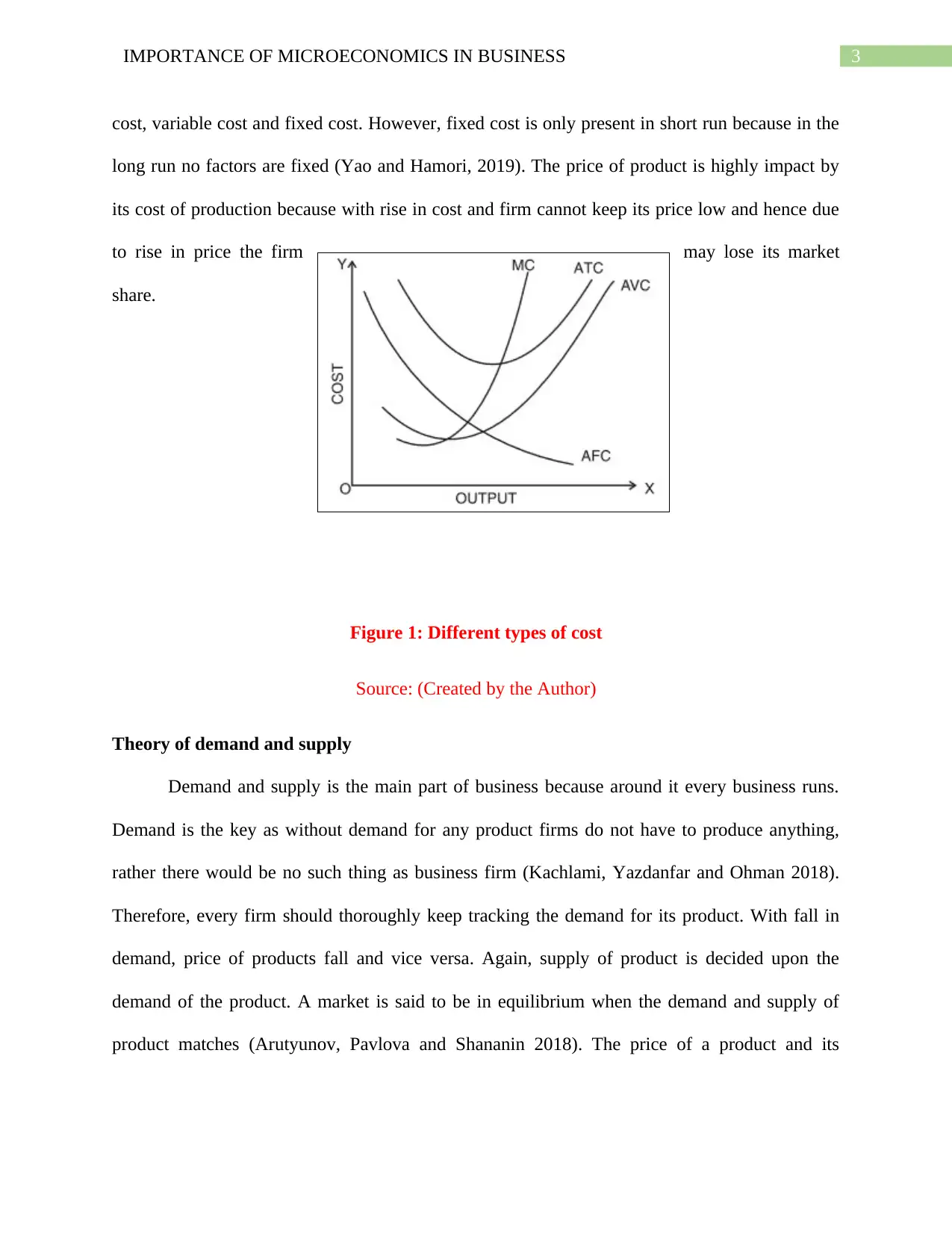
3IMPORTANCE OF MICROECONOMICS IN BUSINESS
cost, variable cost and fixed cost. However, fixed cost is only present in short run because in the
long run no factors are fixed (Yao and Hamori, 2019). The price of product is highly impact by
its cost of production because with rise in cost and firm cannot keep its price low and hence due
to rise in price the firm may lose its market
share.
Figure 1: Different types of cost
Source: (Created by the Author)
Theory of demand and supply
Demand and supply is the main part of business because around it every business runs.
Demand is the key as without demand for any product firms do not have to produce anything,
rather there would be no such thing as business firm (Kachlami, Yazdanfar and Ohman 2018).
Therefore, every firm should thoroughly keep tracking the demand for its product. With fall in
demand, price of products fall and vice versa. Again, supply of product is decided upon the
demand of the product. A market is said to be in equilibrium when the demand and supply of
product matches (Arutyunov, Pavlova and Shananin 2018). The price of a product and its
cost, variable cost and fixed cost. However, fixed cost is only present in short run because in the
long run no factors are fixed (Yao and Hamori, 2019). The price of product is highly impact by
its cost of production because with rise in cost and firm cannot keep its price low and hence due
to rise in price the firm may lose its market
share.
Figure 1: Different types of cost
Source: (Created by the Author)
Theory of demand and supply
Demand and supply is the main part of business because around it every business runs.
Demand is the key as without demand for any product firms do not have to produce anything,
rather there would be no such thing as business firm (Kachlami, Yazdanfar and Ohman 2018).
Therefore, every firm should thoroughly keep tracking the demand for its product. With fall in
demand, price of products fall and vice versa. Again, supply of product is decided upon the
demand of the product. A market is said to be in equilibrium when the demand and supply of
product matches (Arutyunov, Pavlova and Shananin 2018). The price of a product and its
Paraphrase This Document
Need a fresh take? Get an instant paraphrase of this document with our AI Paraphraser
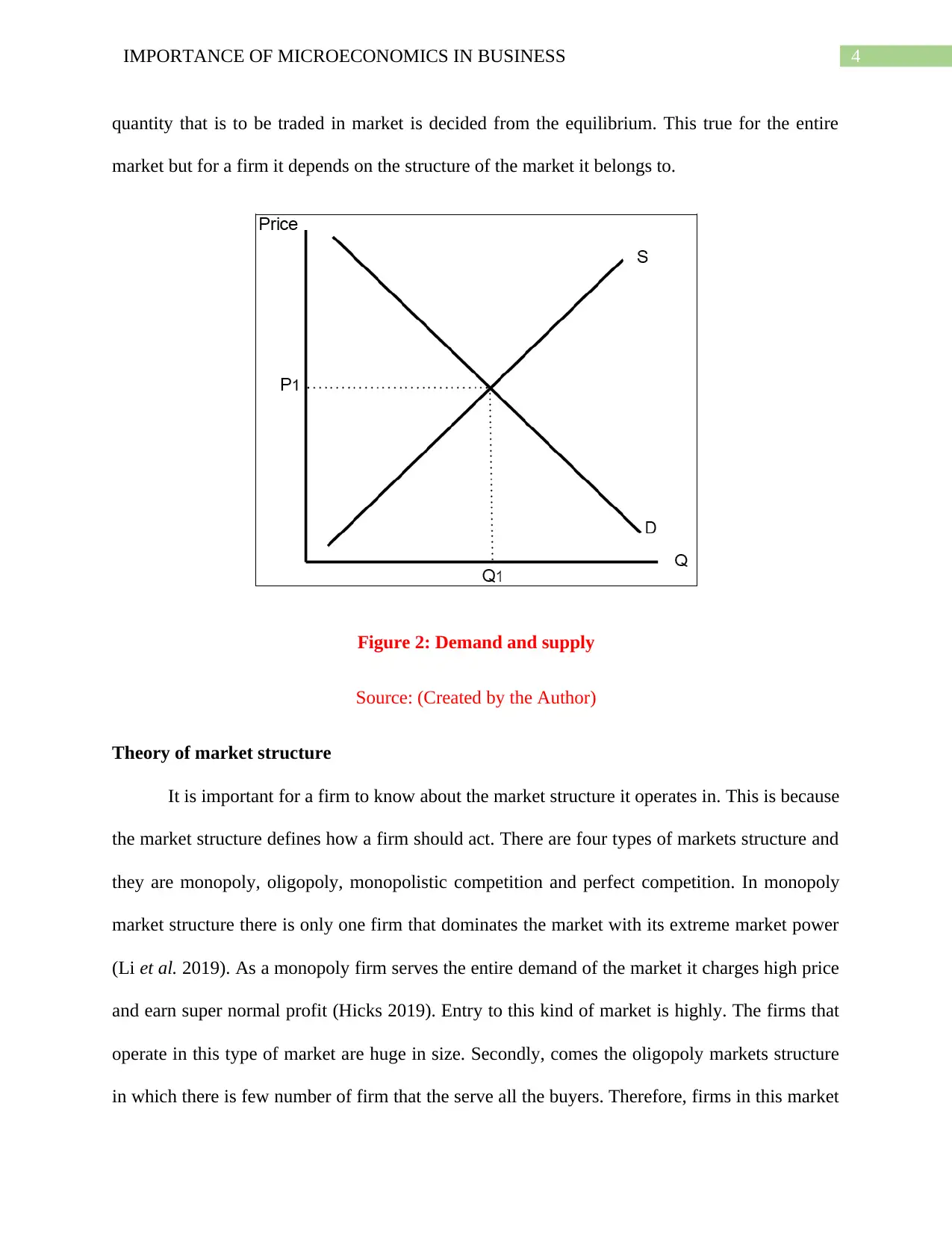
4IMPORTANCE OF MICROECONOMICS IN BUSINESS
quantity that is to be traded in market is decided from the equilibrium. This true for the entire
market but for a firm it depends on the structure of the market it belongs to.
Figure 2: Demand and supply
Source: (Created by the Author)
Theory of market structure
It is important for a firm to know about the market structure it operates in. This is because
the market structure defines how a firm should act. There are four types of markets structure and
they are monopoly, oligopoly, monopolistic competition and perfect competition. In monopoly
market structure there is only one firm that dominates the market with its extreme market power
(Li et al. 2019). As a monopoly firm serves the entire demand of the market it charges high price
and earn super normal profit (Hicks 2019). Entry to this kind of market is highly. The firms that
operate in this type of market are huge in size. Secondly, comes the oligopoly markets structure
in which there is few number of firm that the serve all the buyers. Therefore, firms in this market
quantity that is to be traded in market is decided from the equilibrium. This true for the entire
market but for a firm it depends on the structure of the market it belongs to.
Figure 2: Demand and supply
Source: (Created by the Author)
Theory of market structure
It is important for a firm to know about the market structure it operates in. This is because
the market structure defines how a firm should act. There are four types of markets structure and
they are monopoly, oligopoly, monopolistic competition and perfect competition. In monopoly
market structure there is only one firm that dominates the market with its extreme market power
(Li et al. 2019). As a monopoly firm serves the entire demand of the market it charges high price
and earn super normal profit (Hicks 2019). Entry to this kind of market is highly. The firms that
operate in this type of market are huge in size. Secondly, comes the oligopoly markets structure
in which there is few number of firm that the serve all the buyers. Therefore, firms in this market
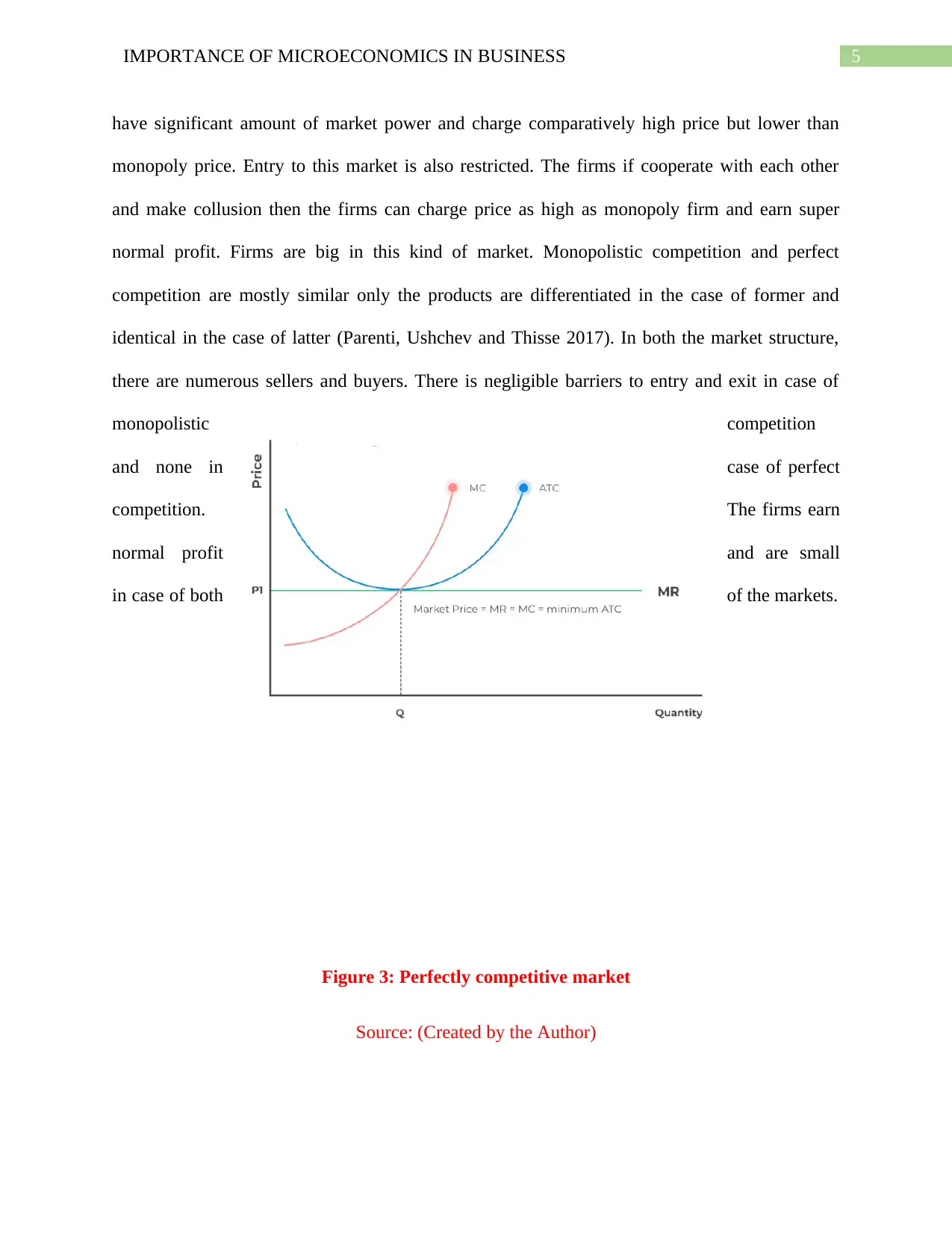
5IMPORTANCE OF MICROECONOMICS IN BUSINESS
have significant amount of market power and charge comparatively high price but lower than
monopoly price. Entry to this market is also restricted. The firms if cooperate with each other
and make collusion then the firms can charge price as high as monopoly firm and earn super
normal profit. Firms are big in this kind of market. Monopolistic competition and perfect
competition are mostly similar only the products are differentiated in the case of former and
identical in the case of latter (Parenti, Ushchev and Thisse 2017). In both the market structure,
there are numerous sellers and buyers. There is negligible barriers to entry and exit in case of
monopolistic competition
and none in case of perfect
competition. The firms earn
normal profit and are small
in case of both of the markets.
Figure 3: Perfectly competitive market
Source: (Created by the Author)
have significant amount of market power and charge comparatively high price but lower than
monopoly price. Entry to this market is also restricted. The firms if cooperate with each other
and make collusion then the firms can charge price as high as monopoly firm and earn super
normal profit. Firms are big in this kind of market. Monopolistic competition and perfect
competition are mostly similar only the products are differentiated in the case of former and
identical in the case of latter (Parenti, Ushchev and Thisse 2017). In both the market structure,
there are numerous sellers and buyers. There is negligible barriers to entry and exit in case of
monopolistic competition
and none in case of perfect
competition. The firms earn
normal profit and are small
in case of both of the markets.
Figure 3: Perfectly competitive market
Source: (Created by the Author)
⊘ This is a preview!⊘
Do you want full access?
Subscribe today to unlock all pages.

Trusted by 1+ million students worldwide
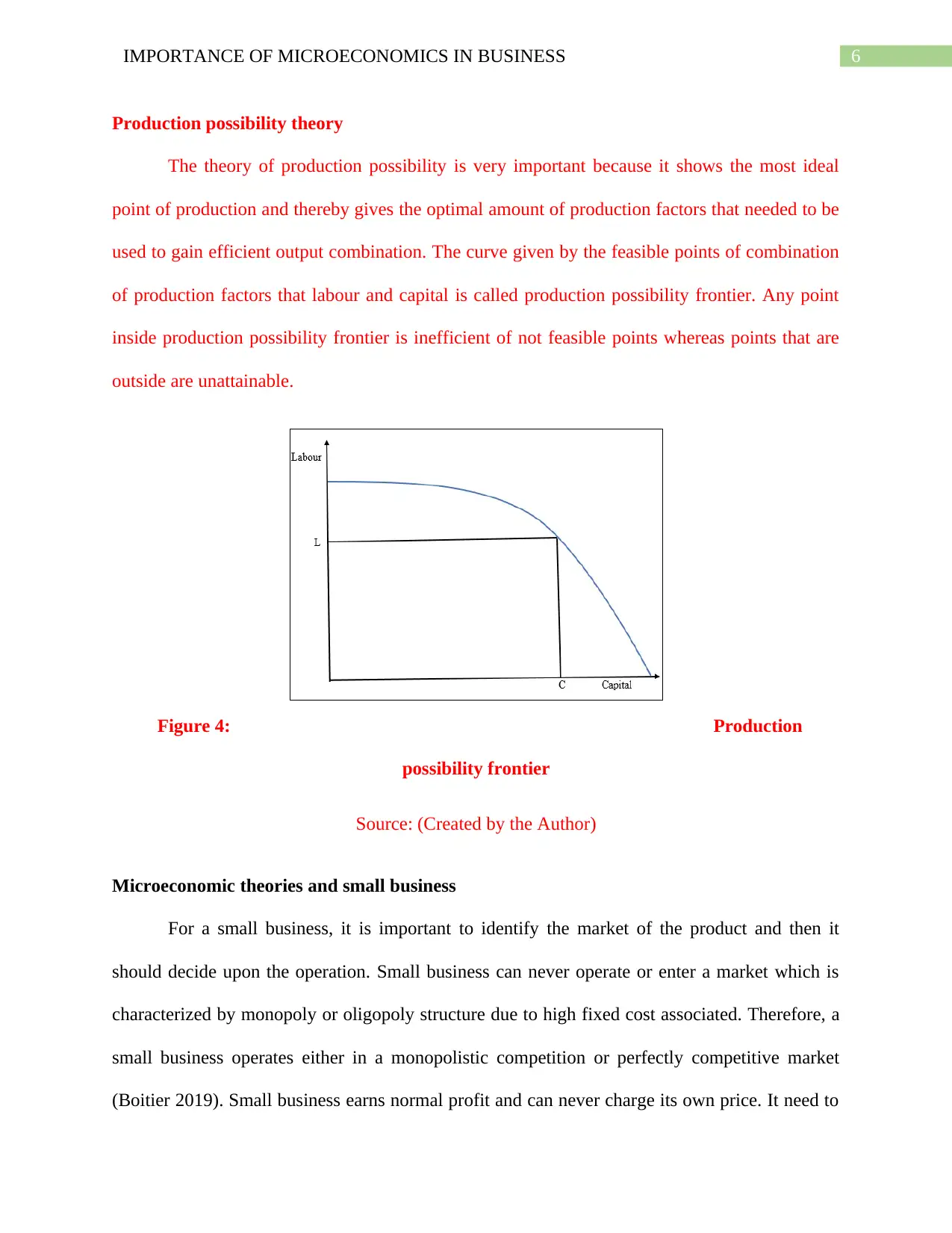
6IMPORTANCE OF MICROECONOMICS IN BUSINESS
Production possibility theory
The theory of production possibility is very important because it shows the most ideal
point of production and thereby gives the optimal amount of production factors that needed to be
used to gain efficient output combination. The curve given by the feasible points of combination
of production factors that labour and capital is called production possibility frontier. Any point
inside production possibility frontier is inefficient of not feasible points whereas points that are
outside are unattainable.
Figure 4: Production
possibility frontier
Source: (Created by the Author)
Microeconomic theories and small business
For a small business, it is important to identify the market of the product and then it
should decide upon the operation. Small business can never operate or enter a market which is
characterized by monopoly or oligopoly structure due to high fixed cost associated. Therefore, a
small business operates either in a monopolistic competition or perfectly competitive market
(Boitier 2019). Small business earns normal profit and can never charge its own price. It need to
Production possibility theory
The theory of production possibility is very important because it shows the most ideal
point of production and thereby gives the optimal amount of production factors that needed to be
used to gain efficient output combination. The curve given by the feasible points of combination
of production factors that labour and capital is called production possibility frontier. Any point
inside production possibility frontier is inefficient of not feasible points whereas points that are
outside are unattainable.
Figure 4: Production
possibility frontier
Source: (Created by the Author)
Microeconomic theories and small business
For a small business, it is important to identify the market of the product and then it
should decide upon the operation. Small business can never operate or enter a market which is
characterized by monopoly or oligopoly structure due to high fixed cost associated. Therefore, a
small business operates either in a monopolistic competition or perfectly competitive market
(Boitier 2019). Small business earns normal profit and can never charge its own price. It need to
Paraphrase This Document
Need a fresh take? Get an instant paraphrase of this document with our AI Paraphraser
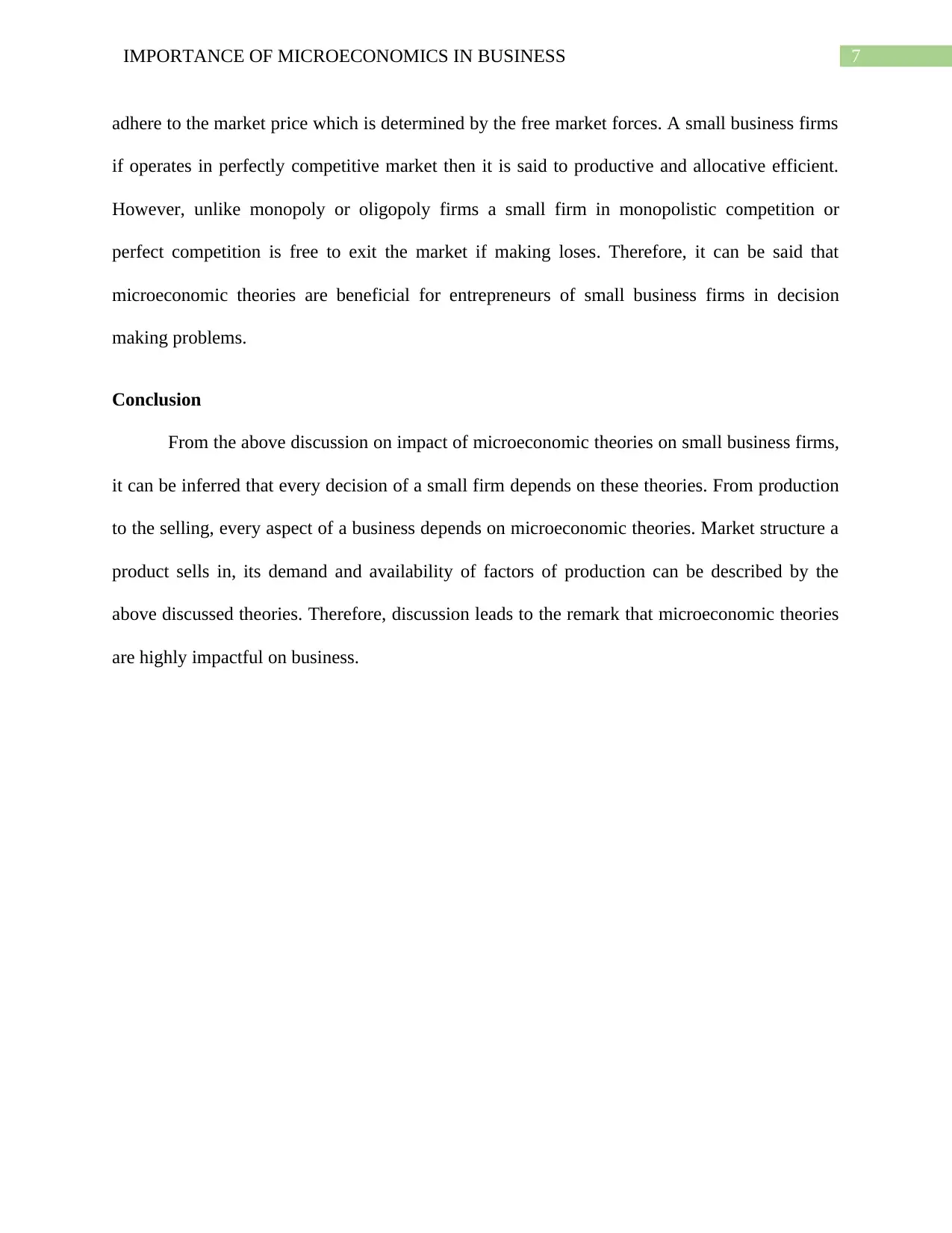
7IMPORTANCE OF MICROECONOMICS IN BUSINESS
adhere to the market price which is determined by the free market forces. A small business firms
if operates in perfectly competitive market then it is said to productive and allocative efficient.
However, unlike monopoly or oligopoly firms a small firm in monopolistic competition or
perfect competition is free to exit the market if making loses. Therefore, it can be said that
microeconomic theories are beneficial for entrepreneurs of small business firms in decision
making problems.
Conclusion
From the above discussion on impact of microeconomic theories on small business firms,
it can be inferred that every decision of a small firm depends on these theories. From production
to the selling, every aspect of a business depends on microeconomic theories. Market structure a
product sells in, its demand and availability of factors of production can be described by the
above discussed theories. Therefore, discussion leads to the remark that microeconomic theories
are highly impactful on business.
adhere to the market price which is determined by the free market forces. A small business firms
if operates in perfectly competitive market then it is said to productive and allocative efficient.
However, unlike monopoly or oligopoly firms a small firm in monopolistic competition or
perfect competition is free to exit the market if making loses. Therefore, it can be said that
microeconomic theories are beneficial for entrepreneurs of small business firms in decision
making problems.
Conclusion
From the above discussion on impact of microeconomic theories on small business firms,
it can be inferred that every decision of a small firm depends on these theories. From production
to the selling, every aspect of a business depends on microeconomic theories. Market structure a
product sells in, its demand and availability of factors of production can be described by the
above discussed theories. Therefore, discussion leads to the remark that microeconomic theories
are highly impactful on business.
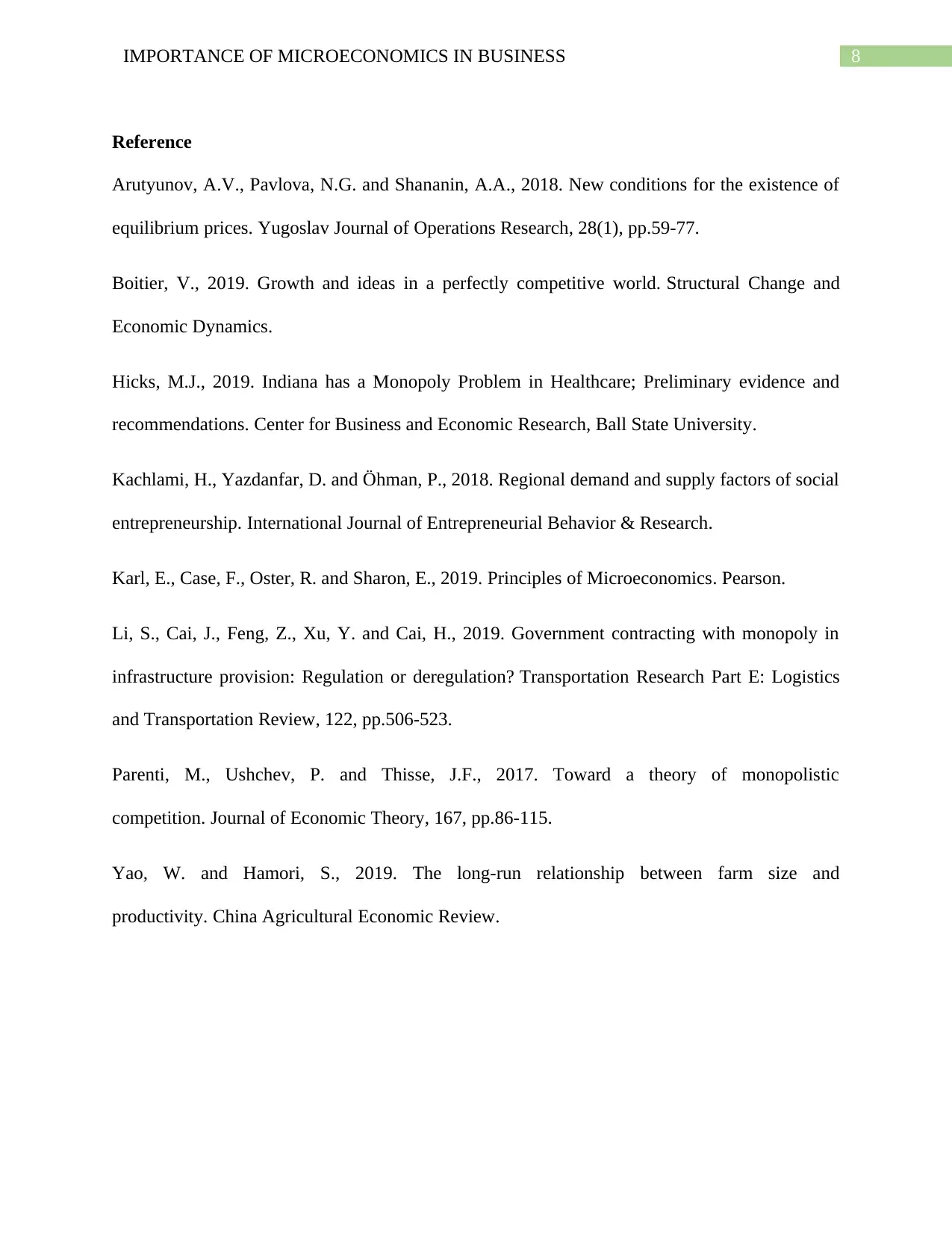
8IMPORTANCE OF MICROECONOMICS IN BUSINESS
Reference
Arutyunov, A.V., Pavlova, N.G. and Shananin, A.A., 2018. New conditions for the existence of
equilibrium prices. Yugoslav Journal of Operations Research, 28(1), pp.59-77.
Boitier, V., 2019. Growth and ideas in a perfectly competitive world. Structural Change and
Economic Dynamics.
Hicks, M.J., 2019. Indiana has a Monopoly Problem in Healthcare; Preliminary evidence and
recommendations. Center for Business and Economic Research, Ball State University.
Kachlami, H., Yazdanfar, D. and Öhman, P., 2018. Regional demand and supply factors of social
entrepreneurship. International Journal of Entrepreneurial Behavior & Research.
Karl, E., Case, F., Oster, R. and Sharon, E., 2019. Principles of Microeconomics. Pearson.
Li, S., Cai, J., Feng, Z., Xu, Y. and Cai, H., 2019. Government contracting with monopoly in
infrastructure provision: Regulation or deregulation? Transportation Research Part E: Logistics
and Transportation Review, 122, pp.506-523.
Parenti, M., Ushchev, P. and Thisse, J.F., 2017. Toward a theory of monopolistic
competition. Journal of Economic Theory, 167, pp.86-115.
Yao, W. and Hamori, S., 2019. The long-run relationship between farm size and
productivity. China Agricultural Economic Review.
Reference
Arutyunov, A.V., Pavlova, N.G. and Shananin, A.A., 2018. New conditions for the existence of
equilibrium prices. Yugoslav Journal of Operations Research, 28(1), pp.59-77.
Boitier, V., 2019. Growth and ideas in a perfectly competitive world. Structural Change and
Economic Dynamics.
Hicks, M.J., 2019. Indiana has a Monopoly Problem in Healthcare; Preliminary evidence and
recommendations. Center for Business and Economic Research, Ball State University.
Kachlami, H., Yazdanfar, D. and Öhman, P., 2018. Regional demand and supply factors of social
entrepreneurship. International Journal of Entrepreneurial Behavior & Research.
Karl, E., Case, F., Oster, R. and Sharon, E., 2019. Principles of Microeconomics. Pearson.
Li, S., Cai, J., Feng, Z., Xu, Y. and Cai, H., 2019. Government contracting with monopoly in
infrastructure provision: Regulation or deregulation? Transportation Research Part E: Logistics
and Transportation Review, 122, pp.506-523.
Parenti, M., Ushchev, P. and Thisse, J.F., 2017. Toward a theory of monopolistic
competition. Journal of Economic Theory, 167, pp.86-115.
Yao, W. and Hamori, S., 2019. The long-run relationship between farm size and
productivity. China Agricultural Economic Review.
⊘ This is a preview!⊘
Do you want full access?
Subscribe today to unlock all pages.

Trusted by 1+ million students worldwide
1 out of 9
Related Documents
Your All-in-One AI-Powered Toolkit for Academic Success.
+13062052269
info@desklib.com
Available 24*7 on WhatsApp / Email
![[object Object]](/_next/static/media/star-bottom.7253800d.svg)
Unlock your academic potential
Copyright © 2020–2025 A2Z Services. All Rights Reserved. Developed and managed by ZUCOL.





